
- Six minutes read
How c-stores and grocers are revolutionizing the checkout experience
Following a pandemic that transformed consumer payment and shopping habits, convenience and grocery stores across the U.S. are deploying easy-to-use solutions to help reduce checkout times and create an enhanced customer experience.
The evolution of the checkout has been rapid, with the pace of change and adoption of new and emerging payment solutions only looking to increase. For convenience and grocery stores in the U.S., understanding the latest trends and dramatic shifts in consumer behaviors has become ever more prevalent as businesses look to mitigate the impact of rising prices brought on by high inflation and supply chain shortages.
Here are some of the ways that merchants are leveraging payments technology to grow their bottom line and ultimately thrive amid ongoing economic uncertainty:
Adopting new payments technology to meet consumer demands
It’s clear that while many trends have evolved since the onset of the COVID-19 pandemic, merchants remain focused on delivering broader convenience to consumers at the checkout. In fact, when it comes to the in-store experience, providing more checkout options can help store operators maintain a competitive advantage as consumer expectations shift and new payment methods become increasingly more popular.
- Embracing contactless technology at all checkout points, including self-service kiosks, to provide customers the convenience and physical safety that many have come to expect. Since becoming more widely available in the U.S., many customers and merchants find 'tapping to pay' to be faster, ultimately speeding up the checkout line. Paysafe’s latest consumer research report, which was released in June 2022, reveals that two-thirds of consumers (67%) indicate that they now regularly make contactless payments with their credit or debit card, with one in ten consumers (9%) confirming all their transactions are now contactless.
- Broadening payments choice for customers by leveling up self-service kiosks to accept both traditional forms of payment and alternative payment methods (APMs), such as digital or mobile wallets. With over a third (39%) of American consumers confirming that their payment habits have changed since the onset of the pandemic, offering quick and easy checkout solutions that take into account how customers want to pay is imperative to winning new business and strengthening relationships with existing clientele. This means merchants are not only embracing new technology from a terminal standpoint, but also prioritizing the various ways in which their customers prefer to pay at the checkout.
- While fixed payment terminals still remain as the most common form of the checkout in the U.S., implementing mobile-based point-of-sale (POS) systems that offer the full functionality to power the checkout experience from anywhere within a store empowers employees to service customers directly – not just at the register. By plugging into mobile-compatible software that transforms smartphone devices and tablets into an autonomous POS system, store operators can help reduce wait times and ultimately speed up the checkout process.
Transitioning to cloud-based technology
Store operators who have recognized the value of adopting cloud-based technology are reaping the rewards. Through cloud-based technology, stores of every size and processing volume can better understand how to maximize sales by accessing real-time data and analytics that provides further insight around consumer payment patterns, as well as patterns in buying behavior. Moving to the cloud also enables merchants to consolidate and streamline their operations, effectively eliminating the need for multiple solutions while minimizing wasteful and costly expenditures. Store operators can manage everything within a single, integrated system, making it possible to easily navigate several key functions all at once, including inventory management, data collection, transactional reconciliation, and even fraud prevention.
Looking beyond the traditional in-store experience
Throughout the early days of the pandemic, which were littered with lockdowns, restrictions, and understandably cautious customer behavior, merchants had to quickly adapt to a new way of offering goods and services to avoid permanent store closures. More merchants began embracing a variety of omnichannel solutions, with the aim of creating a truly frictionless customer experience that bridges both online and brick-and-mortar storefronts. This has led to a proliferation of purchasing options, including enhanced mobile ordering, curb side pick-up, plus the expansion of at-home delivery, all of which enable customers to buy products without needing to enter the store. Now with the return of shopping in-person, consumers continue to favor the speed and convenience of the omnichannel experience, further demonstrating the importance of utilizing multiple sales channels to offer broader payments choice and ultimately reach more customers.




